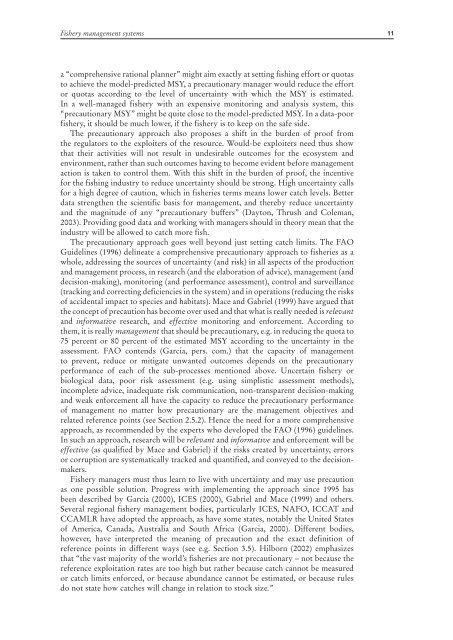Stock assessment for fishery management - Library
Stock assessment for fishery management - Library
Stock assessment for fishery management - Library
You also want an ePaper? Increase the reach of your titles
YUMPU automatically turns print PDFs into web optimized ePapers that Google loves.
Fishery <strong>management</strong> systems 11a “comprehensive rational planner” might aim exactly at setting fishing ef<strong>for</strong>t or quotasto achieve the model-predicted MSY, a precautionary manager would reduce the ef<strong>for</strong>tor quotas according to the level of uncertainty with which the MSY is estimated.In a well-managed <strong>fishery</strong> with an expensive monitoring and analysis system, this“precautionary MSY” might be quite close to the model-predicted MSY. In a data-poor<strong>fishery</strong>, it should be much lower, if the <strong>fishery</strong> is to keep on the safe side.The precautionary approach also proposes a shift in the burden of proof fromthe regulators to the exploiters of the resource. Would-be exploiters need thus showthat their activities will not result in undesirable outcomes <strong>for</strong> the ecosystem andenvironment, rather than such outcomes having to become evident be<strong>for</strong>e <strong>management</strong>action is taken to control them. With this shift in the burden of proof, the incentive<strong>for</strong> the fishing industry to reduce uncertainty should be strong. High uncertainty calls<strong>for</strong> a high degree of caution, which in fisheries terms means lower catch levels. Betterdata strengthen the scientific basis <strong>for</strong> <strong>management</strong>, and thereby reduce uncertaintyand the magnitude of any “precautionary buffers” (Dayton, Thrush and Coleman,2003). Providing good data and working with managers should in theory mean that theindustry will be allowed to catch more fish.The precautionary approach goes well beyond just setting catch limits. The FAOGuidelines (1996) delineate a comprehensive precautionary approach to fisheries as awhole, addressing the sources of uncertainty (and risk) in all aspects of the productionand <strong>management</strong> process, in research (and the elaboration of advice), <strong>management</strong> (anddecision-making), monitoring (and per<strong>for</strong>mance <strong>assessment</strong>), control and surveillance(tracking and correcting deficiencies in the system) and in operations (reducing the risksof accidental impact to species and habitats). Mace and Gabriel (1999) have argued thatthe concept of precaution has become over used and that what is really needed is relevantand in<strong>for</strong>mative research, and effective monitoring and en<strong>for</strong>cement. According tothem, it is really <strong>management</strong> that should be precautionary, e.g. in reducing the quota to75 percent or 80 percent of the estimated MSY according to the uncertainty in the<strong>assessment</strong>. FAO contends (Garcia, pers. com.) that the capacity of <strong>management</strong>to prevent, reduce or mitigate unwanted outcomes depends on the precautionaryper<strong>for</strong>mance of each of the sub-processes mentioned above. Uncertain <strong>fishery</strong> orbiological data, poor risk <strong>assessment</strong> (e.g. using simplistic <strong>assessment</strong> methods),incomplete advice, inadequate risk communication, non-transparent decision-makingand weak en<strong>for</strong>cement all have the capacity to reduce the precautionary per<strong>for</strong>manceof <strong>management</strong> no matter how precautionary are the <strong>management</strong> objectives andrelated reference points (see Section 2.5.2). Hence the need <strong>for</strong> a more comprehensiveapproach, as recommended by the experts who developed the FAO (1996) guidelines.In such an approach, research will be relevant and in<strong>for</strong>mative and en<strong>for</strong>cement will beeffective (as qualified by Mace and Gabriel) if the risks created by uncertainty, errorsor corruption are systematically tracked and quantified, and conveyed to the decisionmakers.Fishery managers must thus learn to live with uncertainty and may use precautionas one possible solution. Progress with implementing the approach since 1995 hasbeen described by Garcia (2000), ICES (2000), Gabriel and Mace (1999) and others.Several regional <strong>fishery</strong> <strong>management</strong> bodies, particularly ICES, NAFO, ICCAT andCCAMLR have adopted the approach, as have some states, notably the United Statesof America, Canada, Australia and South Africa (Garcia, 2000). Different bodies,however, have interpreted the meaning of precaution and the exact definition ofreference points in different ways (see e.g. Section 3.5). Hilborn (2002) emphasizesthat “the vast majority of the world’s fisheries are not precautionary – not because thereference exploitation rates are too high but rather because catch cannot be measuredor catch limits en<strong>for</strong>ced, or because abundance cannot be estimated, or because rulesdo not state how catches will change in relation to stock size.”
















